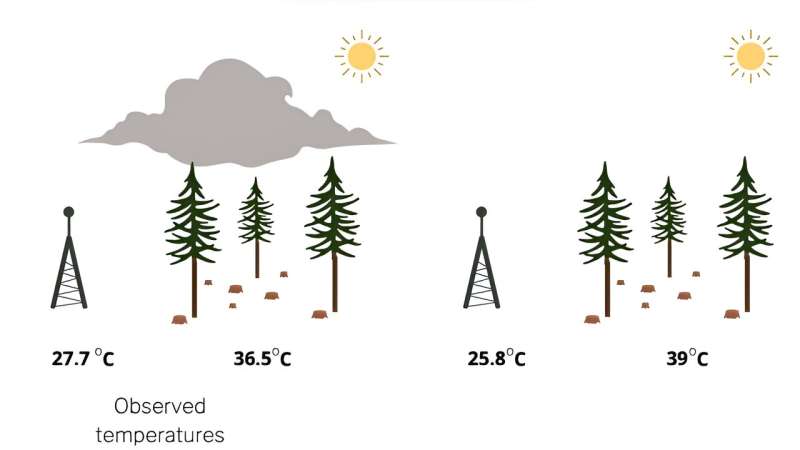This article has been reviewed according to Science X's editorial process and policies. Editors have highlighted the following attributes while ensuring the content's credibility:
fact-checked
trusted source
proofread
Wildfire smoke has a silver lining: It can protect vulnerable tree seedlings

Forest scientists at Oregon State University studying tree regeneration have found that wildfire smoke comes with an unexpected benefit: It has a cooling capacity that can make life easier for vulnerable seedlings.
An OSU College of Forestry collaboration led by faculty research assistant Amanda Brackett made the discovery while working to determine the effect of forest canopy cover on summer maximum temperatures near ground level.
The goal of the study, published in the Canadian Journal of Forest Research, was to describe how heat waves and other future climate conditions might affect canopy cover's influence on temperature.
The scientists used previously established heat stress responses of seedlings from laboratory studies to look at temperature-induced stress to conifer seedlings and germinating seeds under different canopy conditions.
"Tree regeneration is an indicator of forest resilience and an important ecological process, but young seedlings are extra vulnerable to heat stress," Brackett said.
"Our results show that while overstory canopy cover may help buffer temperature stress experienced by seedlings, extreme heat events and climate change still pose significant challenges—and that wildfire smoke can actually be beneficial."
Brackett and colleagues Chris Still and Klaus Puettman created a metric called stress degree hours to show the duration and intensity of high temperatures that exceed levels that hinder tree regeneration.
"This work shows that widespread smoke from wildfires can lead to unanticipated beneficial effects by reducing sunlight at the surface and thus lowering the temperatures experienced by vulnerable tree seedlings, even during extreme summer weather like the 2021 heat dome period," said Still, a professor who studies climate change feedbacks and impacts on forests.
In summer 2021, the scientists examined 11 different stands of recently thinned, 50-year-old Douglas-fir in the Upper Blue River Watershed in western Oregon's Willamette National Forest, measuring air temperatures at 2 centimeters above ground on south-facing slopes. The study area was heavily affected by wildfire smoke in August 2021 because of the Middle Fork Complex and Washington Ponds fires.
Overall, and after accounting for the influences of topography, they found that for every 10% increase in canopy cover, maximum temperatures at 2 centimeters were 1.3°C lower, the odds of temperatures exceeding stress thresholds for conifer regeneration fell by one-fourth, and total stress degree hours decreased by 40%.
"Those reductions are large enough to be worthy of attention when managing for tree regeneration," Brackett said. "But data collected during the Pacific Northwest heat dome in June 2021 indicate that with various climate change scenarios and heat wave occurrences, temperatures will be unfavorable for regeneration regardless of canopy cover."
During the heat dome, the highest temperature near the soil surface the scientists recorded was 57.4°C, or just over 135°F.
Smoke's impact on maximum and average near-surface temperature was similar to the temperature reduction caused by an increase of 15% in canopy cover, Brackett said.
The finding is line with the idea that while smoke can cause a range of concerns, fire is a natural forest occurrence with ecological upsides.
"Smoke absorbs and scatters incoming solar radiation, reducing how much reaches the forest floor, but we did not anticipate seeing this level of impact," she said. "That extra cooling effect may be important during extreme heat events when canopy cover and topography do not provide enough protection from harmful and potentially lethal temperatures in the understory."
Tree regeneration is a critical part of creating the diverse structure associated with healthy, multi-aged forests, she said, adding that the study highlights the need to consider conditions experienced by young seedlings when designing and implementing forest treatments.
"Managers need to understand how microclimate varies under a range of overstory conditions," Brackett said. "Given climate predictions, scientists and managers have to look for opportunities to increase individual tree and forest-level resilience to a hotter and more extreme climate.
"Wildfire smoke will continue to affect ecosystems and while we documented an unanticipated benefit, more work is needed to untangle other potential impacts."
More information: Amanda Brackett et al, Residual canopy cover provides buffering of near-surface temperatures, but benefits are limited under extreme conditions, Canadian Journal of Forest Research (2024). DOI: 10.1139/cjfr-2023-0268
Provided by Oregon State University




















